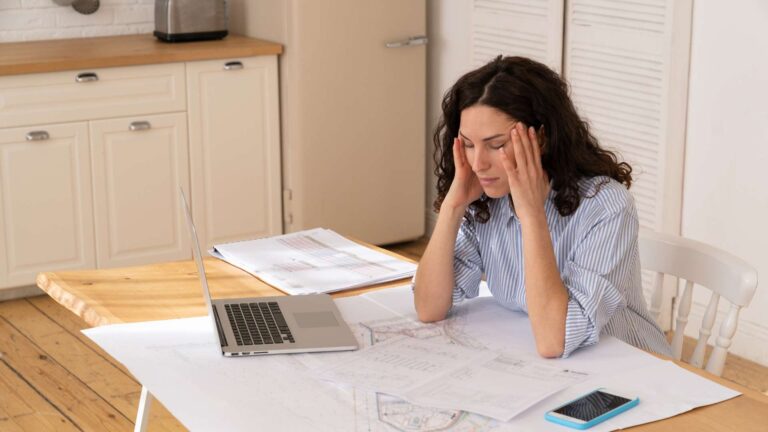Table of Contents
As real estate and money coaches, we often see the same pattern repeat itself: excited first-time buyers who meticulously plan for their down payment and monthly mortgage, only to face financial shock when the true costs of homeownership become apparent. The monthly mortgage payment represents just the beginning of homeownership expenses, not the end.
Most buyers focus intensely on qualifying for their loan and scraping together the down payment, believing these hurdles represent the biggest financial challenges of homeownership. We’ve compiled the most common hidden costs that consistently surprise new homeowners, causing budget stress and sometimes forcing families to reconsider their housing decisions. Here are the hidden costs of homeownership.
Property Taxes That Keep Rising Every Year
Property taxes represent one of the most persistent and unpredictable costs of homeownership that first-time buyers often underestimate. Unlike mortgage payments that remain fixed, property taxes increase regularly based on local government needs and property value assessments.
- The Annual Surprise: Most buyers see the current property tax amount during their home search and assume it remains constant. Reality proves different as property taxes typically increase 3-5% annually, sometimes more during periods of rapid appreciation or increased municipal spending.
- Assessment Shock: Local tax assessors periodically revalue properties based on current market conditions and any improvements made to them. A home with $4,000 in annual property taxes at purchase might increase to $ 6,000 or more within five years due to market appreciation and assessment increases.
- Geographic Variations: Property tax rates vary significantly by location, ranging from under 0.5% of the home value in some states to over 2.5% in others. A $400,000 home might incur $2,000 annually in low-tax states, versus $ 10,000 or more in high-tax areas.
- Budget Planning: We recommend budgeting for 4-6% annual property tax increases to avoid payment shock. Consider property taxes as seriously as mortgage payments when determining housing affordability, since both represent non-negotiable monthly obligations.
Home Insurance That Costs More Than You Think
Home insurance costs consistently exceed the expectations of first-time buyers, particularly when comprehensive coverage and location-specific risks are factored in. Basic homeowners insurance provides a foundation, but adequate protection requires additional coverage that substantially increases premiums.
Coverage Complexity: Standard homeowners insurance typically excludes many common risks, including floods, earthquakes, and certain types of weather events. Adding comprehensive protection often doubles or triples initial insurance quotes that covered only basic perils.
Geographic Risk Factors: Homes located in hurricane-prone coastal areas, wildfire regions, or flood zones require specialized coverage, which can cost $ 2,000 to $5,000 or more annually. Even homes outside obvious risk zones may need supplemental coverage due to changing weather patterns and updated risk assessments.
Annual Premium Increases: Home insurance premiums rise consistently due to increased claim costs, inflation in construction materials, and changing risk assessments. Budget for 5-8% annual premium increases to avoid coverage gaps when renewal costs exceed expectations.
Deductible Considerations: Lower deductibles mean higher premiums, while higher deductibles reduce annual costs but increase out-of-pocket expenses during claims. Balance deductible amounts with your emergency fund capacity to handle potential claims costs.
The 1-3% Annual Maintenance Rule Everyone Ignores
Home maintenance represents perhaps the most underestimated ongoing cost of homeownership, with expenses that can’t be delayed or avoided without risking major system failures and expensive emergency repairs.
- The Mathematical Reality: Financial experts recommend budgeting 1-3% of your home’s value annually for maintenance and repairs. On a $400,000 home, this translates to $4,000-$ 12,000 per year, money that must be available regardless of your cash flow or other financial priorities.
- System Replacement Cycles: Major home systems have predictable lifespans requiring eventual replacement. HVAC systems last 15-20 years ($5,000-15,000 replacement), roofs need replacement every 20-30 years ($10,000-25,000), and water heaters fail every 8-12 years ($1,200-3,000 replacement).
- Preventive vs Emergency Costs: Regular maintenance prevents expensive emergency failures but requires consistent investment. Annual HVAC servicing ($200-$400) can prevent $5,000 or more in emergency replacements, while roof inspections ($300-$500) can prevent $15,000 or more in emergency repairs.
- Seasonal Expense Clustering: Home maintenance costs often cluster seasonally, with spring and fall requiring significant investment in systems, landscaping, and exterior maintenance. Budget monthly for maintenance expenses rather than trying to cover everything during peak seasons.
PMI That Doesn’t Disappear Automatically
Private Mortgage Insurance (PMI) represents a significant monthly expense for buyers with a down payment of less than 20%. However, many buyers are unaware of the requirements for maintaining and removing PMI.
Cost Calculation: PMI typically costs 0.3-1.5% of your loan amount annually, depending on credit score, loan type, and down payment amount. On a $320,000 loan, PMI ranges from $960 to $4,800 annually, adding $80 to $400 to monthly housing costs.
Removal Requirements: PMI doesn’t automatically cancel when you reach 20% equity through appreciation or principal payments. You must request removal, which often requires a new appraisal costing $400-$ 600 to establish the current home value and equity position.
Refinancing Alternative: Rising property values might create opportunities to refinance and eliminate PMI even before reaching 20% equity through principal payments. Monitor local appreciation rates and consider refinancing when property values increase substantially.
Timing Strategy: Some buyers opt for PMI rather than depleting their savings for 20% down payments, thereby preserving cash for emergencies and future home improvements. This strategy is effective when investment returns exceed PMI costs and when removal becomes feasible within a reasonable timeframe.
HOA Fees That Increase Without Warning
Homeowners Association fees represent ongoing monthly expenses that many first-time buyers underestimate, particularly regarding fee increases and special assessments that can dramatically impact housing budgets.
- Fee Structure Variations: HOA fees range from $50 to $200 monthly in basic communities to $500 to $1,000 or more in luxury developments with extensive amenities. These fees cover common area maintenance, insurance, reserves, and amenities, and are typically subject to annual increases due to rising costs and community improvements.
- Special Assessment Shock: HOAs can levy special assessments for major repairs, improvements, or reserve fund shortfalls. Roof replacements, parking lot resurfacing, or building exterior work can result in special assessments of $5,000-$ 20,000, with payment requirements of 30-90 days.
- Limited Owner Control: HOA boards control fee increases and special assessments, providing individual owners with limited input on costs. Review HOA financial statements, reserve studies, and board meeting minutes before purchase to understand potential future costs.
- Amenity Trade-offs: HOA communities offer amenities such as pools, fitness centers, and landscaping, but these benefits come with ongoing costs that persist regardless of personal usage. Evaluate whether amenity access justifies ongoing HOA expenses based on your lifestyle and priorities.
Utility Costs That Dwarf Apartment Living
Utility costs typically increase dramatically when moving from apartments to houses due to larger spaces, individual metering, and additional services that landlords previously covered.
Size Impact: Heating and cooling larger spaces substantially increases utility costs. A 900-square-foot apartment might cost $100-$ 150 monthly for utilities, while a 2,000-square-foot house often costs $250-$400 or more monthly due to increased energy consumption.
Individual Responsibility: Apartments often include utilities in rent or benefit from shared costs across multiple units. Homeowners are responsible for handling all utility costs individually, including services such as trash collection, water, sewer, and sometimes internet, which were previously included in the rent.
Seasonal Variations: Utility costs fluctuate seasonally due to varying heating and cooling needs. Budget for peak winter and summer months when heating and cooling costs can double normal consumption, creating cash flow challenges during extreme weather periods.
Efficiency Investments: Older homes often have inefficient systems requiring higher utility consumption. Consider efficiency improvements, such as updated HVAC systems, insulation, and windows, that reduce long-term utility costs while requiring an upfront investment.

Landscaping and Lawn Care Nobody Warns You About
Landscaping and lawn care represent ongoing expenses that apartment dwellers often overlook, but homeowners must address them regardless of their personal interest or expertise in outdoor maintenance.
- Establishment Costs: New homes often lack mature landscaping, requiring an initial investment of $3,000 to $8,000 or more for basic trees, shrubs, lawn establishment, and irrigation systems. Even homes with existing landscaping need refreshing and replacement over time.
- Ongoing Maintenance: Professional lawn care costs $100-$300 per month, depending on the property size and service level. Include fertilization, weed control, seasonal cleanup, and equipment maintenance for comprehensive property care.
- Equipment Investment: DIY lawn care requires a significant investment in equipment, including mowers ($ 300-$2,000+), trimmers, leaf blowers, and hand tools. Equipment maintenance, fuel, and eventual replacement add ongoing costs that many first-time owners don’t anticipate.
- Seasonal Services: Many regions require seasonal services, such as snow removal, leaf cleanup, or irrigation system maintenance, which cost between $200 and $800 per service, depending on the property size and local rates.
Moving and Setup Costs That Add Up Fast
Moving costs extend far beyond hiring professional movers, encompassing numerous expenses that quickly accumulate during the transition from rental to homeownership.
Professional Moving Services: Local moves typically cost $1,000-$ 2,500, while long-distance moves range from $3,000-$7,000+, depending on the distance and household size. Include packing materials, insurance, and potential storage costs if timing doesn’t align perfectly.
Utility Connection Fees: Establishing utility service typically requires deposits ($100-$500 per utility) and connection fees ($50-$200 per service). Some utilities require larger deposits for customers without an established credit history in the service area.
Immediate Necessity Purchases: New homes often require immediate purchases, such as garage door openers, window treatments, basic tools, and security systems. These necessities can easily cost $2,000 to $ 5,000 before considering furniture and decorative items.
Home Setup Expenses: Larger homes typically require more furniture, appliances, and household items than smaller rental spaces. Budget $5,000-$15,000+ for basic furnishing needs, depending on the home’s size and the adequacy of existing furniture.
Professional Services You Never Needed Before
Homeownership requires professional services that apartment dwellers often never encounter, resulting in ongoing expenses for specialized maintenance and repairs that can’t be handled personally.
- Annual System Servicing: HVAC systems require annual maintenance ($150-$400), chimneys need periodic cleaning and inspection ($200-$500), and septic systems require pumping every 3-5 years ($200-$600). These services prevent expensive failures but require consistent budgeting and planning.
- Emergency Repair Services: Plumbing emergencies, electrical issues, and appliance failures require immediate professional attention, often incurring costs of $ 200-$800 or more per visit. Maintain relationships with reliable service providers to avoid emergency service premiums during crises.
- Specialized Inspections: Home systems require periodic professional inspections, including termite inspections ($100-$300), radon testing ($150-$400), and structural assessments when problems arise. These inspections often reveal additional repair needs requiring professional attention.
- Seasonal Services: Many homeowners require seasonal professional services, such as gutter cleaning ($150-$400), pressure washing ($200-$600), and window cleaning ($200-$500), to maintain their property’s condition and prevent damage from neglect.
Conclusion
First-time homebuyers who budget only for mortgage, taxes, and insurance typically underestimate their total housing costs by $500-$ 1,500 per month. The hidden costs of homeownership are often predictable and can catch buyers off guard because they are rarely discussed during the excitement of home shopping. Success in homeownership comes from budgeting for reality rather than best-case scenarios.
For any financial aid, you can check out Beem, a smart wallet app trusted by over 5 million Americans, with features from cash advances to help with budgeting and tax calculations. In addition, Beem’s Everdraft™ lets you withdraw up to $1,000 instantly with no checks. Download the app here.















































